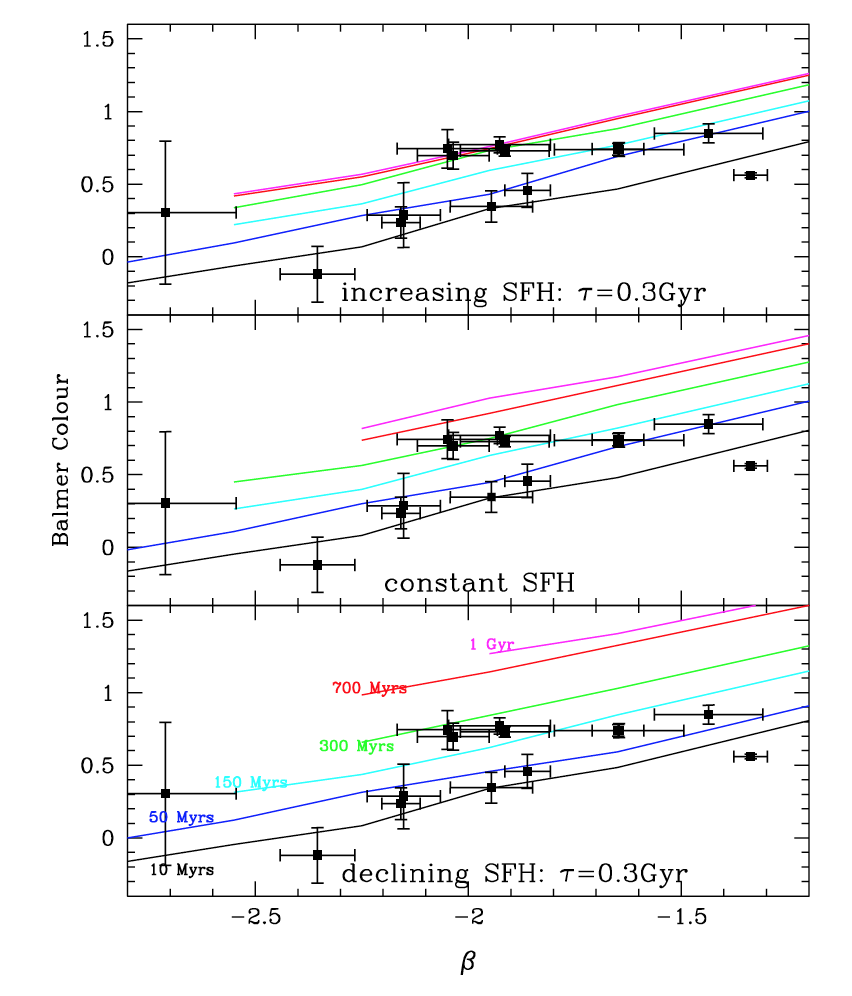The main aim of this work is to constrain the assembly history of high-redshift galaxies and the reliability of UV-based estimates of their physical parameters from an accurate analysis of a unique sample of z ~ 3 Lyman-break galaxies (LBGs).
We analyse 14 LBGs at z ~ 2.8-3.8 constituting the only sample where both a spectroscopic measurement of their metallicity and deep IR observations (CANDELS+HUGS survey) are available. Fixing the metallicity of population synthesis models to the observed values, we determine best-fit physical parameters under different assumptions about the star-formation history (SFH) and also consider the effect of nebular emission. For comparison, we determine the UV slope of the objects, and use it to estimate their SFRUV99 by correcting the UV luminosity.

Amplitude of the Balmer break as a function of the UV slope for the objects in our sample (black squares and error-bars) compared to templates at different ages (continous lines: 0.01 Gyr to 1 Gyr from bottom to top) and star-formation histories: exponentially declining SFH (τ = 0.3 Gyr, bottom panel), constant SFH (central panel), exponentially increasing SFH (τ = 0.3 Gyr, top panel). The Balmer colour is defined as H160-0.5 × (K+3.6 μm) for objects and templates at z > 3.4, and J125-0.5× (K+3.6 μm) for lower redshifts. The reddening vector in this plot is parallel to the displayed model tracks.
A comparison between star-formation rate (SFR) obtained through SED-fitting (SFRfit) and the SFRUV99 shows that the latter are underestimated by a factor of 2-10, regardless of the assumed SFH. Other SFR indicators (radio, far-IR, X-ray, recombination lines) coherently indicate SFRs a factor of 2-4 larger than SFRUV99 and in closer agreement with SFRfit. This discrepancy is due to the solar metallicity implied by the usual beta – A1600 conversion factor. We propose a refined relation, appropriate for subsolar metallicity LBGs:
A1600 = 5.32 + 1.99 * beta.
This relation reconciles the dust-corrected UV with the SED-fitting and the other SFR indicators. We show that the fact that z ~ 3 galaxies have subsolar metallicity implies an upward revision by a factor of ~1.5-2 of the global SFRD, depending on the assumptions about the age of the stellar populations. We find very young best-fit ages (10-500 Myr) for all our objects. From a careful examination of the uncertainties in the fit and the amplitude of the Balmer break we conclude that there is little evidence of the presence of old stellar population in at least half of the LBGs in our sample, suggesting that these objects are probably caught during a huge star-formation burst, rather than being the result of a smooth evolution.
The full paper describing technical details about the UV-sloper determination can be found in Castellano et al. 2014, A&A, 566, 19.
